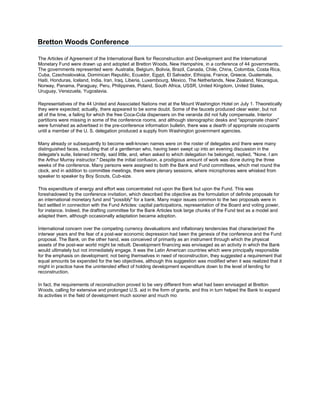
Bretton woods conference
- 1. Bretton Woods Conference The Articles of Agreement of the International Bank for Reconstruction and Development and the International Monetary Fund were drawn up and adopted at Bretton Woods, New Hampshire, in a conference of 44 governments. The governments represented were: Australia, Belgium, Bolivia, Brazil, Canada, Chile, China, Colombia, Costa Rica, Cuba, Czechoslovakia, Dominican Republic, Ecuador, Egypt, El Salvador, Ethiopia, France, Greece, Guatemala, Haiti, Honduras, Iceland, India, Iran, Iraq, Liberia, Luxembourg, Mexico, The Netherlands, New Zealand, Nicaragua, Norway, Panama, Paraguay, Peru, Philippines, Poland, South Africa, USSR, United Kingdom, United States, Uruguay, Venezuela, Yugoslavia. Representatives of the 44 United and Associated Nations met at the Mount Washington Hotel on July 1. Theoretically they were expected; actually, there appeared to be some doubt. Some of the faucets produced clear water, but not all of the time, a failing for which the free Coca-Cola dispensers on the veranda did not fully compensate. Interior partitions were missing in some of the conference rooms, and although stenographic desks and "appropriate chairs" were furnished as advertised in the pre-conference information bulletin, there was a dearth of appropriate occupants until a member of the U. S. delegation produced a supply from Washington government agencies. Many already or subsequently to become well-known names were on the roster of delegates and there were many distinguished faces, including that of a gentleman who, having been swept up into an evening discussion in the delegate's suite, listened intently, said little, and, when asked to which delegation he belonged, replied, "None. I am the Arthur Murray instructor." Despite the initial confusion, a prodigious amount of work was done during the three weeks of the conference. Many persons were assigned to both the Bank and Fund committees, which met round the clock, and in addition to committee meetings, there were plenary sessions, where microphones were whisked from speaker to speaker by Boy Scouts, Cub-size. This expenditure of energy and effort was concentrated not upon the Bank but upon the Fund. This was foreshadowed by the conference invitation, which described the objective as the formulation of definite proposals for an international monetary fund and "possibly" for a bank. Many major issues common to the two proposals were in fact settled in connection with the Fund Articles: capital participations, representation of the Board and voting power, for instance. Indeed, the drafting committee for the Bank Articles took large chunks of the Fund text as a model and adapted them, although occasionally adaptation became adoption. International concern over the competing currency devaluations and inflationary tendencies that characterized the interwar years and the fear of a post-war economic depression had been the genesis of the conference and the Fund proposal. The Bank, on the other hand, was conceived of primarily as an instrument through which the physical assets of the post-war world might be rebuilt. Development financing was envisaged as an activity in which the Bank would ultimately but not immediately engage. It was the Latin American countries which were principally responsible for the emphasis on development; not being themselves in need of reconstruction, they suggested a requirement that equal amounts be expended for the two objectives, although this suggestion was modified when it was realized that it might in practice have the unintended effect of holding development expenditure down to the level of lending for reconstruction. In fact, the requirements of reconstruction proved to be very different from what had been envisaged at Bretton Woods, calling for extensive and prolonged U.S. aid in the form of grants, and this in turn helped the Bank to expand its activities in the field of development much sooner and much mo
